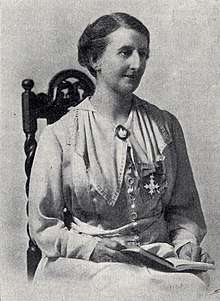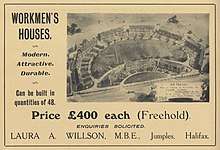Laura Annie Willson
Laura Annie Willson MBE (née Buckley) (15 August 1877 – 17 April 1942) was an English engineer and suffragette, who was twice imprisoned for her political activities. She was one of the founding members of the Women's Engineering Society and was the first female member of the Federation of House Builders.
Laura Annie Willson MBE | |
|---|---|
 Laura Anne Willson c.1925 | |
| Born | Laura Annie Buckley 15 August 1877 Halifax, Yorkshire, England |
| Died | 17 April 1942 (aged 64) Walton-on-Thames, Surrey, England |
| Nationality | English |
| Occupation | Engineer, housebuilder, women's rights campaigner |
| Spouse(s) | George Henry Willson |
| Children | George William, Kathleen Vega |
| Awards | Member of the Order of the British Empire (MBE) |
Early life and factory career
Laura Annie Buckley was born on 15 August 1877 in Halifax, Yorkshire to Charles Buckley (1836/7–1899), dyer’s labourer, and Augusta, née Leaver (1838/9–1907).[1] She started work at the age of ten as a 'half-timer' in a local textile factory.[2] Half time in factories was introduced to spare children from working a full day; instead they worked half the day and spent the rest of the time at school, which was often built within the factory compound.[3]
When she married George Henry Willson in 1899, she was described as a worsted coating weaver. Her husband was a maker of machine tools who established a successful engineering works in Halifax, which she would help to run. The Willson's had two children, George (born in 1900) and Kathleen Vega, known as Vega, (born 1910).
She became strongly involved in the trade union movement, becoming branch secretary of the Women's Labour League in Halifax in 1907.[4][5] She was also a secretary of the Halifax branch of the Women's Social and Political Union which formed in January 1906.[6]
In 1907, she took part in a weavers' strike at Hebden Bridge, where she was arrested for 'inciting persons to commit a breach of the peace'. Appearing at the magistrates court, she challenged the legitimacy of the court's exclusively male constitution, demanding to be either tried by her peers or be provided with a women lawyer[7]. She was found guilty and sentenced to fourteen days in prison. On her release, Willson reportedly said 'I went to gaol a rebel, but I have come out a regular terror'[8]. Weeks later, she was one of 75 women arrested after a suffragette rally at Caxton Hall. She was sentenced to fourteen days in Holloway Prison[9].
She was a joint-director of the lathe-making factory Smith Barker & Willson with her husband, which during the First World War produced munitions. The predominately female workforce were trained and supervised by Laura Annie. Noticing that some of the employees were going without food so that their children could eat, she established a works canteen to ensure that the women were properly nourished. This idea was adopted by factories across the United Kingdom.[1] In 1917, the same year the Order of the British Empire honours were instituted, she was awarded an MBE for her contribution to 'Women's Work in Munitions'. [5]
Engineering career

In 1919, she co-founded the Women's Engineering Society (WES) with Rachel Parsons, Margaret, Lady Moir, Lady Katharine Parsons, Eleanor Shelley-Rolls, Margaret Rowbotham and Janetta Mary Ornsby.[10][11] The aim of WES was to protect the positions that women had gained in industry during World War I, and to promote equal opportunities for women in engineering. She was president of WES from 1926 to 1928.[12]
She became the first woman member of the Federation of House Builders,[13] constructing 72 houses for workers in Halifax in 1925–26.[5] She was a founding member of the Electrical Association for Women in 1924, alongside Caroline Haslett;[2] this interest was reflected in her housing estates which had the latest gas and electricity appliances.[13] In 1927, having moved to Surrey from Halifax with her husband, Willson continued her trade as a builder by purchasing land at Englefield Green.[14]
References
- Heald, Henrietta (12 July 2018). Willson [née Buckley], Laura Annie (1877–1942), suffragette, engineer, and businesswoman. 1. Oxford University Press. doi:10.1093/odnb/9780198614128.013.107536.
- "Willson, Laura Ann". Historic England.
- Hobbs, Sandy; McKechnie, Jim; Lavalette, Michael (1 January 1999). Child Labor: A World History Companion. ABC-CLIO. p. 111. ISBN 9780874369564.
what is a 'half timer' in a factory.
- Liddington, Jill (3 September 2015). Rebel Girls: How votes for women changed Edwardian lives. Little, Brown Book Group. ISBN 9780349007816.
- Law, Cheryl (1 January 2000). Women, A Modern Political Dictionary. I.B.Tauris. p. 159. ISBN 9781860645020.
Laura Ann Willson.
- Crawford, Elizabeth (15 December 2016). The Women's Suffrage Movement in Britain and Ireland: A Regional Survey. Taylor & Francis. ISBN 9780415383325.
- "Suffragettes Go To Gaol". Manchester Courier and Lancashire General Advertiser. 8 February 1907. Retrieved 18 January 2020 – via British Library Newspapers.
- Heald, Henrietta. "Magnificent Women and their Revolutionary Machines". Retrieved 18 January 2020.
- "Roll of Honour of Suffragette Prisoners 1905-1914". Retrieved 18 January 2020.
- Law, Cheryl (22 April 2000). Suffrage and Power: The Women's Movement 1918–1928. I.B.Tauris. ISBN 9781860644788.
- Heald, Henrietta, author. (2019). Magnificent women and their revolutionary machines. ISBN 978-1-78352-660-4. OCLC 1080083743.CS1 maint: multiple names: authors list (link)
- "Presidents Past & Present | Women's Engineering Society". www.wes.org.uk. Retrieved 15 December 2016.
- England, Historic. "Architects, Builders and Garden Cities | Historic England". historicengland.org.uk. Retrieved 15 December 2016.
- "News - Exploring Surrey's Past". www.exploringsurreyspast.org.uk. Retrieved 15 December 2016.